Bringing a Brown Ragdoll cat into your home is an exciting and rewarding experience. These cats are known for their striking blue eyes, soft semi-long fur, and affectionate personalities. Brown Ragdoll cat adoption gives you the chance to welcome a loyal and loving companion who thrives on human interaction. Ragdolls are often called “puppy-like” because they follow their owners around and enjoy being held and cuddled, making them a great choice for families, singles, and seniors alike.
Before adopting a Brown Ragdoll, you need to understand their needs and prepare your home accordingly. Adoption involves more than just bringing a cat home—it requires commitment, knowledge, and the right environment to ensure a smooth transition. You must choose between adopting from a shelter or purchasing from a breeder, set up a cat-friendly space, and learn how to care for their health, diet, and grooming needs.
This guide covers the top 10 tips for Brown Ragdoll cat adoption. You’ll learn how to pick the right adoption route, prepare your home, and provide the best care for your new feline companion. By following these tips, you can ensure your Ragdoll thrives in a loving and comfortable environment.
Understanding the Brown Ragdoll Cat Breed
Brown Ragdoll Cat Personality
Brown Ragdoll cat adoption is a rewarding experience for anyone looking for a gentle, affectionate, and social feline companion. Ragdolls love human companionship and often follow their owners around the house, earning them the nickname “puppy cats.” Unlike independent or aloof felines, they enjoy being held, cuddled, and even carried around. Many Ragdolls will flop into their owner’s arms when picked up, fully trusting them—this is one of the breed’s most charming traits.
These cats thrive in homes where they receive plenty of attention. Brown Ragdoll cat adoption is ideal for families, seniors, and even multi-pet households, as these cats get along well with children, other cats, and even dogs. Their calm demeanor makes them perfect for indoor living, but they still need mental stimulation and playtime to stay happy. If you work long hours, consider adopting another cat to keep your Ragdoll company. They don’t like being left alone for extended periods and can become lonely or anxious without companionship.
Ragdolls also have a playful side. They enjoy interactive toys, feather wands, and puzzle feeders that engage their intelligence. Training them is relatively easy since they respond well to positive reinforcement. You can teach them tricks, commands, or even how to walk on a leash. Brown Ragdoll cat adoption ensures you bring home an affectionate, adaptable, and intelligent pet that will form a deep bond with your family.
Brown Ragdoll Cat Coat Colors
The Brown Ragdoll is just one of the many stunning color variations within the Ragdoll breed. These cats have a semi-long, silky coat that requires regular grooming to maintain its softness and shine. While the term “brown” isn’t an officially recognized color in Ragdolls, some variations appear brownish due to their unique color patterns. Officially recognized coat colors include seal, chocolate, blue, lilac, cream, red, and variations with tortie or lynx patterns.
Most Ragdolls have pointed coloration, meaning their ears, face, paws, and tail appear darker than the rest of their body. This distinctive color pattern develops as they grow since Ragdoll kittens are born pure white. Over time, their fur darkens, revealing their true colors. A Brown Ragdoll might actually be a seal or chocolate point, but their coat can appear warm brown under certain lighting.
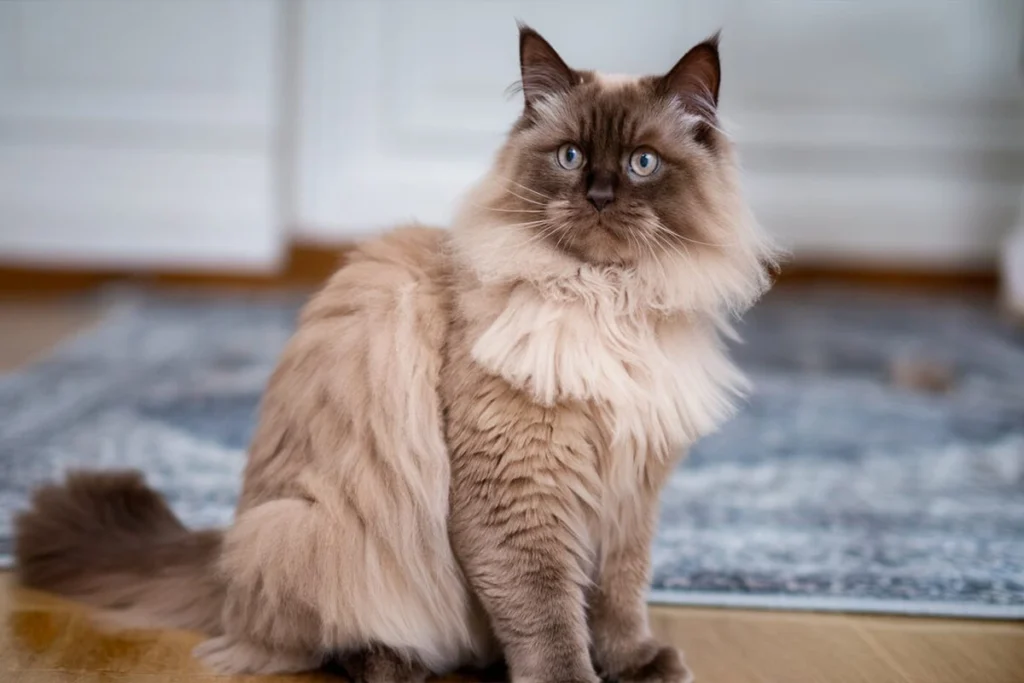
Ragdoll cats also come in different patterns:
- Colorpoint: A solid contrast between the darker points and lighter body.
- Mitted: White “mittens” on their paws and a white chin or belly stripe.
- Bicolor: A white inverted “V” on the face, white chest, and legs.
- Lynx and Tortie Variations: Striped or mottled patterns that add unique visual appeal.
Regardless of their exact shade, Ragdolls require regular brushing to prevent tangles and reduce shedding. Their coats don’t mat as easily as some long-haired breeds, but maintaining a grooming routine ensures they stay soft and beautiful.
Brown Ragdoll Cat Nutrition
Feeding a Brown Ragdoll cat a well-balanced diet keeps them healthy, energetic, and at an ideal weight. These cats have a muscular build but can become overweight if overfed or given too many treats. A high-quality diet rich in protein and essential nutrients supports their overall well-being.
Key nutritional needs for Ragdoll cats:
- High-quality animal protein: Look for foods with real meat, such as chicken, turkey, or fish, as the first ingredient. Protein supports muscle development and energy levels.
- Healthy fats: Omega-3 and Omega-6 fatty acids promote a shiny coat and support brain health.
- Low carbohydrates: Avoid grain-heavy diets or foods with fillers like corn, wheat, and soy, as they provide little nutritional value.
- Essential vitamins and minerals: Taurine, an amino acid crucial for heart and eye health, must be present in their diet. Calcium and phosphorus also play a role in bone strength.
Ragdolls thrive on a mix of wet and dry food. Wet food provides hydration and prevents urinary tract issues, while dry kibble helps maintain dental health. Fresh water should always be available, and cat owners should monitor portion sizes to prevent obesity.
Treats should make up no more than 10% of their daily calorie intake. Instead of overfeeding, engage them in play sessions to encourage movement and maintain a healthy weight. Proper nutrition, combined with regular vet checkups, keeps Ragdolls healthy and full of life.
Choosing the Right Brown Ragdoll Cat Adoption Route: Rescue vs. Breeder
Cat Adoption Centers & Pet Shelters
Brown Ragdoll cat adoption from a pet shelter or cat adoption center provides a loving home to a cat in need. Many Ragdolls end up in shelters due to unforeseen circumstances, such as owners moving, allergies, or financial difficulties. Choosing adoption not only gives a deserving cat a second chance but also helps reduce the number of homeless pets.
Start your search by visiting local shelters, rescue groups, or organizations specializing in Brown Ragdoll cat adoption. Some rescues focus exclusively on purebred cats and may have Ragdolls available. Online adoption platforms like Petfinder and Adopt-a-Pet allow you to filter searches by breed and location, making it easier to find a Brown Ragdoll near you.
Before adopting, ask the shelter about the cat’s medical history, personality, and any special needs. Some rescued Ragdolls may need extra patience and care if they have experienced neglect or abandonment. However, many Ragdolls in shelters are friendly, well-adjusted, and ready to become part of a loving family. Brown Ragdoll cat adoption fees typically cover spaying/neutering, vaccinations, and initial veterinary checkups, making it a cost-effective option compared to buying from a breeder.
If you choose adoption, prepare for a transition period. Your new cat may need time to adjust to a new environment, especially if they previously lived in a shelter. Provide a quiet, comfortable space and introduce them gradually to their new home. With love and patience, a rescued Ragdoll will bond with you and become a devoted companion.
Best Brown Ragdoll Cat Breeders
If you decide to adopt a Brown Ragdoll kitten from a breeder, choose a responsible and ethical breeder who prioritizes the health and well-being of their cats. Reputable breeders follow high breeding standards, conduct genetic testing, and ensure kittens receive proper veterinary care before going to their new homes.
Start your search by looking for breeders registered with TICA (The International Cat Association) or CFA (Cat Fanciers’ Association). These organizations maintain strict guidelines for ethical breeding practices. A good breeder will provide detailed health records, including vaccinations, deworming schedules, and genetic testing for common Ragdoll health concerns like hypertrophic cardiomyopathy (HCM).
When evaluating breeders, look for these key signs of responsible breeding:
- Clean and well-maintained environment: Kittens should be raised in a safe, loving home, not in cages or overcrowded conditions.
- Healthy and socialized kittens: Well-bred Ragdolls should be playful, curious, and comfortable around people.
- Transparent health guarantees: Reputable breeders offer health guarantees and provide documentation of veterinary checkups.
- No early weaning: Ethical breeders keep kittens with their mother for at least 12 weeks to ensure proper socialization.
Avoid breeders who refuse to show their facilities, do not provide health records, or rush the sale. Responsible breeders genuinely care about their cats and will ask you questions to ensure their kittens go to loving, prepared homes. While purchasing from a breeder costs more than adopting from a shelter, it guarantees you receive a well-bred, healthy Ragdoll kitten.
TICA (The International Cat Association)
The International Cat Association (TICA) is one of the world’s largest organizations for pedigree cat breeding and registration, playing a crucial role in Brown Ragdoll cat adoption. TICA sets high standards for breeders, ensuring they follow ethical practices and prioritize feline health. If you are looking for a Brown Ragdoll kitten, finding a breeder registered with TICA helps guarantee that the cat comes from a reputable source.
TICA-registered breeders adhere to strict guidelines that promote responsible breeding. They conduct genetic testing to prevent hereditary diseases and ensure that kittens meet the breed’s standard for temperament, coat color, and structure. Brown Ragdoll cat adoption from a TICA-registered breeder also provides official pedigree documentation, allowing you to verify a kitten’s lineage and ensure it has been raised in a healthy, caring environment.
Beyond breeding standards, TICA plays an essential role in the cat-loving community. The organization hosts cat shows, educates owners about feline care, and supports rescue efforts. Whether you adopt from a shelter or purchase from a breeder, checking for TICA registration ensures that your Ragdoll meets breed standards and has received proper care from birth.
If you plan to show or breed your Ragdoll in the future, TICA registration becomes even more important. It provides proof of your cat’s pedigree and allows you to participate in official cat shows and competitions. Even if you simply want a pet, choosing a TICA-registered breeder for Brown Ragdoll cat adoption gives you peace of mind about your cat’s quality and health.
Preparing Your Home for a Brown Ragdoll Cat
Cat-Friendly Home Setup
Before bringing a Brown Ragdoll cat into your home, create a comfortable and safe environment that meets their needs. Ragdolls are known for their affectionate and relaxed nature, but they still require a stimulating space where they can feel secure and entertained.
Start by setting up a designated cat area with essentials like a cozy bed, food and water bowls, and a litter box. Ragdolls love soft surfaces, so provide plush blankets or padded cat beds where they can lounge. Choose a quiet, low-traffic space for their litter box to encourage consistent use and minimize stress.
Scratching posts and cat trees play an essential role in your Ragdoll’s home setup. These cats enjoy climbing and stretching, so a sturdy cat tree allows them to observe their surroundings from a higher vantage point. Scratching posts prevent destructive behavior and help maintain their claws. Position these near areas where your cat spends the most time.
Invest in interactive toys and enrichment activities to keep your Ragdoll entertained. Feather wands, puzzle feeders, and catnip toys engage their natural instincts and prevent boredom. Since Ragdolls enjoy human interaction, schedule daily playtime to strengthen your bond and provide mental stimulation.
Ensure your home remains cat-proof by removing toxic plants, securing electrical cords, and keeping small objects that could be swallowed out of reach. Ragdolls adapt well to indoor living, but if you plan to allow supervised outdoor time, use a secure cat harness or build a catio (cat patio) for safe outdoor exploration.
Cat Socialization
Ragdolls thrive on companionship and human interaction, making socialization an essential part of their well-being. From the moment you bring your Brown Ragdoll home, focus on creating positive experiences that help them adjust and build confidence in their new environment.
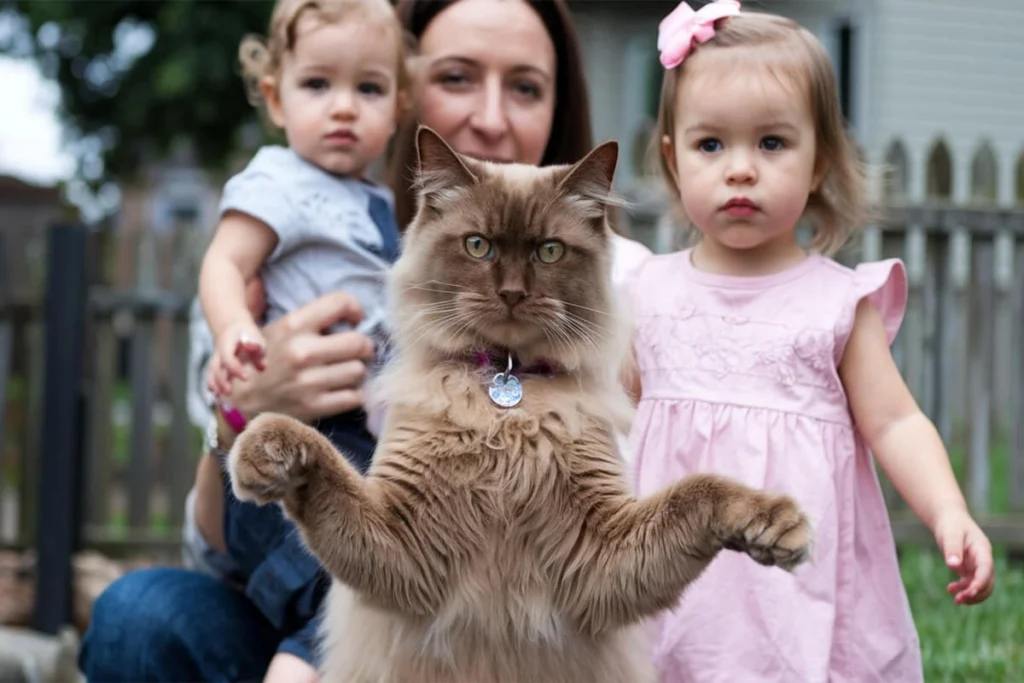
Begin with a slow introduction to their new home. Instead of giving your cat access to the entire house immediately, start with one quiet room where they can feel safe. Place their food, water, litter box, and bed in this space and allow them to explore at their own pace. Once they appear comfortable, gradually introduce them to other areas of your home.
If you have other pets, introduce them carefully. Ragdolls generally get along well with other cats and even dogs, but the process should be gradual. Start by allowing them to sniff each other’s scent through a door or blanket before meeting face-to-face. Use controlled, short meetings and reward both pets with treats to encourage positive interactions.
Regular handling helps reinforce your bond with your Ragdoll. Since they enjoy being held and cuddled, gently pet them, pick them up for short periods, and talk to them in a soft voice. Offer treats and praise to create a sense of trust. Ragdolls respond well to positive reinforcement and can even learn tricks or commands with patience and consistency.
Expose your cat to different household sounds and experiences so they become comfortable in various situations. Play soft music, introduce them to guests, and allow them to explore different textures and surfaces. Proper socialization helps prevent anxiety and ensures your Ragdoll remains friendly and confident throughout their life.
Responsible Pet Ownership
Owning a Brown Ragdoll cat comes with a long-term commitment to their health, happiness, and well-being. These affectionate cats rely on their owners for proper care, attention, and a loving home environment. Responsible pet ownership begins with understanding the lifelong commitment involved in caring for a Ragdoll.
Prioritize regular veterinary checkups and preventive care. Ragdolls require routine vaccinations, flea and tick prevention, and annual health assessments to catch potential issues early. Schedule checkups at least once a year, and monitor your cat’s behavior for any signs of illness, such as changes in appetite, energy levels, or litter box habits.
Provide a balanced diet that supports their overall health. Choose high-quality cat food rich in protein, healthy fats, and essential nutrients. Avoid feeding them table scraps or foods that could be harmful, such as onions, garlic, or chocolate. Fresh water should always be available to prevent dehydration and urinary tract issues.
Ensure your Ragdoll stays active to maintain a healthy weight. While these cats have a laid-back nature, they still need daily playtime to stay fit. Interactive toys, feather wands, and treat-dispensing puzzles keep them engaged and prevent boredom. Overfeeding or lack of exercise can lead to obesity, which increases the risk of health problems like diabetes and joint issues.
Spaying or neutering your cat contributes to responsible pet ownership by preventing unwanted litters and reducing certain health risks. Spayed or neutered cats tend to have longer, healthier lives and exhibit fewer behavioral issues like territorial spraying or aggression.
Lastly, always consider your cat’s emotional well-being. Ragdolls crave companionship and may become anxious or depressed if left alone for long periods. If you have a busy schedule, adopt a second cat to keep them company or arrange interactive play sessions to keep them engaged. Creating a loving, stable environment ensures your Ragdoll remains a happy and well-adjusted member of your family.
Essential Ragdoll Cat Care Tips
Ragdoll Cat Diet and Grooming
Feeding your Brown Ragdoll cat a well-balanced diet ensures they stay healthy, energetic, and at an ideal weight. Ragdolls are a large breed with a sturdy build, so they need nutrient-rich food that supports their muscle mass and overall well-being.
Optimal Diet for Ragdoll Cats
Choose high-quality cat food with real meat as the first ingredient. Protein plays a crucial role in muscle development, and Ragdolls require a diet that includes chicken, turkey, fish, or beef. Avoid foods filled with by-products, artificial additives, or excessive carbohydrates, as these offer little nutritional value.
Essential nutrients for a Ragdoll’s diet:
- Animal-based protein: Supports muscle growth and energy levels.
- Healthy fats (Omega-3 & Omega-6): Promote a shiny coat, reduce inflammation, and support brain function.
- Taurine: An important amino acid that helps keep your heart and eyes healthy.
- Hydration: Wet food or added moisture in meals helps prevent urinary tract issues, a common concern for Ragdolls.
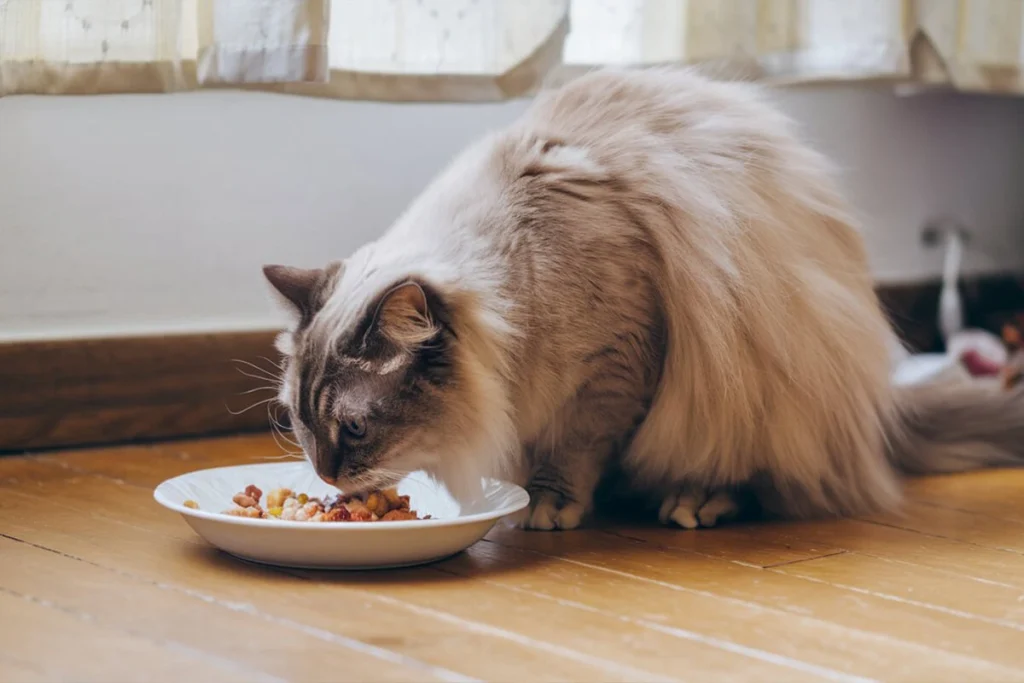
A combination of wet and dry food keeps your cat hydrated while supporting their dental health. Offer portion-controlled meals to prevent obesity, a condition that Ragdolls can be prone to due to their laid-back nature. Fresh water should always be available, and Treats should be only a small part of what they eat each day. It should not be more than 10% of their total calories.
Grooming Your Ragdoll Cat
Ragdolls have a luxurious, semi-long coat that requires regular maintenance to stay soft and tangle-free. Unlike some long-haired breeds, their fur does not mat easily, but a consistent grooming routine keeps shedding under control and reduces hairballs.
Brushing:
- Use a stainless-steel comb or a soft bristle brush to remove loose hairs and prevent knots.
- Brush at least twice a week, focusing on areas where fur is denser, like the chest and tail.
- Increase brushing frequency during seasonal shedding periods in spring and fall.
Bathing:
- Ragdolls rarely need baths unless they get exceptionally dirty.
- Use a cat-friendly shampoo to maintain their coat’s softness and natural oils.
Nail trimming:
- Trim their claws every two to three weeks to prevent overgrowth and scratching injuries.
Ear and eye care:
- Check their ears for wax buildup or infections and clean them with a vet-approved solution.
- Wipe away any tear stains from their eyes using a soft, damp cloth.
A proper diet and grooming routine keep your Ragdoll looking and feeling their best. Regular care also strengthens your bond and helps you spot potential health issues early.
Ragdoll Cat Health Care
Caring for your Brown Ragdoll’s health requires a proactive approach. Since Ragdolls are prone to certain hereditary conditions, staying informed about their well-being ensures they live a long and happy life.
Common Health Concerns in Ragdolls
Ragdolls generally enjoy good health, but some genetic conditions affect this breed more frequently than others.
- Hypertrophic Cardiomyopathy (HCM): A common heart condition in cats, HCM thickens the heart muscles, leading to potential heart failure. Regular vet checkups and genetic screening can help detect early signs.
- Polycystic Kidney Disease (PKD): A condition that causes cysts to form in the kidneys, potentially leading to kidney failure. Proper hydration and a kidney-friendly diet can help manage symptoms.
- Urinary Tract Issues: Ragdolls may develop urinary crystals or infections, so providing plenty of fresh water and feeding moisture-rich food helps prevent these problems.
- Obesity: Since Ragdolls are naturally large cats, extra weight can put strain on their joints, increasing the risk of arthritis and diabetes. A balanced diet and regular playtime help maintain a healthy weight.
Preventive Health Care for Ragdolls
- Routine vet visits: Schedule an annual exam to check for underlying health issues and ensure vaccinations remain up to date.
- Balanced diet and hydration: Feeding high-quality food and ensuring proper hydration supports their long-term health.
- Dental care: Ragdolls, like all cats, need proper dental hygiene to prevent gum disease. Use dental treats or brush their teeth with cat-friendly toothpaste.
- Parasite prevention: Flea, tick, and worm treatments protect your Ragdoll from common parasites that can affect their overall health.
By focusing on preventive care, you can reduce the risk of serious health conditions and ensure your Ragdoll enjoys a happy and active life.
Cat Vaccinations & Vet Checkups
Keeping up with vaccinations and regular vet checkups plays a vital role in your Ragdoll’s overall health. Vaccinations protect against common feline diseases, while routine checkups help catch potential issues before they become severe.
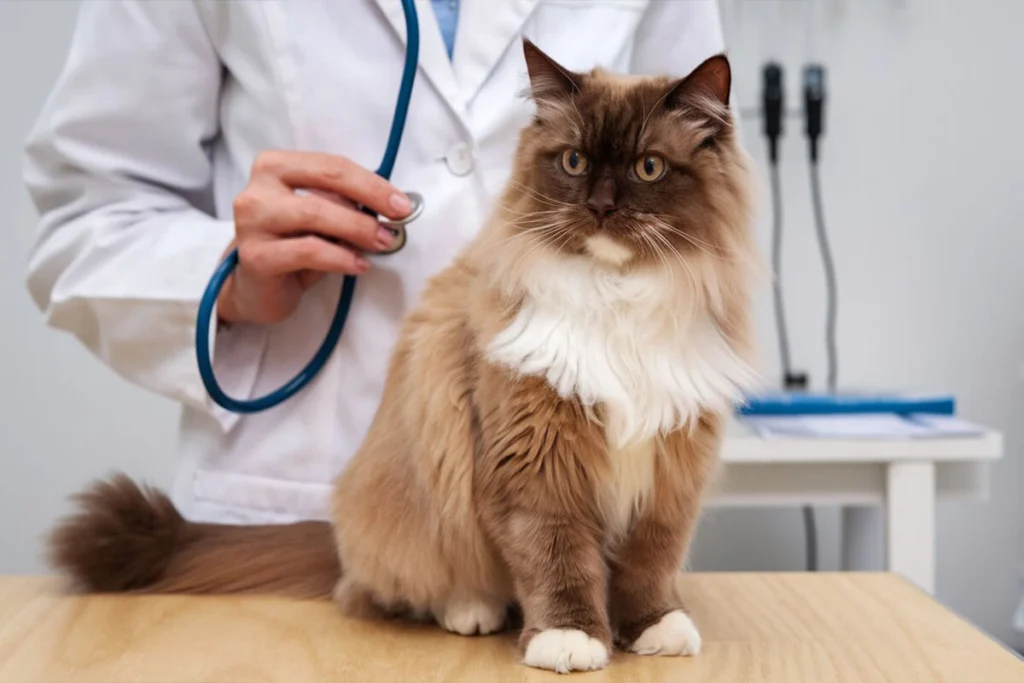
Essential Vaccinations for Ragdoll Cats
Your veterinarian will recommend a vaccination schedule based on your cat’s lifestyle and risk factors. Core vaccines protect against highly contagious and dangerous diseases, while non-core vaccines depend on your cat’s exposure to certain environments.
Core Vaccines (Recommended for All Cats):
- FVRCP (Feline Viral Rhinotracheitis, Calicivirus, Panleukopenia): Protects against respiratory infections and feline distemper.
- Rabies: Required by law in many places, rabies vaccinations protect both cats and humans from this fatal disease.
Non-Core Vaccines (Given Based on Risk):
- FeLV (Feline Leukemia Virus): Recommended for outdoor cats or those exposed to other felines.
- FIP (Feline Infectious Peritonitis): Offered in certain cases, but not always necessary.
Routine Vet Checkups and Health Monitoring
Regular veterinary visits ensure early detection of health issues and help maintain your cat’s overall well-being.
What to Expect During a Vet Visit:
- A full physical exam, including weight, heart, and lung checks.
- Blood tests for potential health concerns like kidney or liver disease.
- Dental checkups to monitor gum health and prevent dental disease.
- Parasite screening to detect fleas, ticks, and intestinal worms.
Schedule annual checkups for adult Ragdolls, and consider biannual visits for senior cats. If you notice sudden weight loss, changes in appetite, or unusual behavior, schedule a vet appointment immediately.
Following a proper vaccination schedule and attending regular checkups ensure your Brown Ragdoll cat remains healthy and protected throughout their life.
Helping Your Ragdoll Settle into Their New Home
Adopt a Ragdoll Cat Successfully
Bringing a Brown Ragdoll cat into your home requires preparation, patience, and commitment. Since Ragdolls are affectionate, social cats, they thrive in loving environments where they receive attention and proper care. Understanding the adoption process, choosing the right cat, and preparing for the transition help ensure a successful experience for both you and your new feline companion.
Choosing the Right Ragdoll for Your Home
Before adopting, consider whether you want a kitten or an adult cat. Kittens require more time and training, while adult Ragdolls often have established personalities and may adjust more easily to home life. If you prefer to adopt from a shelter, check with cat adoption centers or Ragdoll-specific rescues to find a Brown Ragdoll in need of a home.
When selecting a cat, observe their personality. Ragdolls are known for their gentle and affectionate nature, but each cat has a unique temperament. Some may be more playful, while others are calmer and prefer lounging. Ask the breeder or shelter about the cat’s behavior, health history, and any special needs.
Completing the Adoption Process
Most adoption centers and reputable breeders follow a structured adoption process, which may include:
- An application form to assess your suitability as a pet owner.
- An interview or home visit to ensure a safe environment.
- Adoption fees that often cover vaccinations, microchipping, and spaying/neutering.
Once approved, bring home your Ragdoll with the essentials in place to make the transition smooth and stress-free.
Helping Your Ragdoll Adjust to Their New Home
When your cat arrives, introduce them to a quiet, designated space where they can feel safe. Let them explore gradually and avoid overwhelming them with too much activity on the first day. Speak softly, allow them to come to you, and provide familiar-smelling items like blankets or toys to help them settle in.
Patience is key during the first few days. Some cats adjust quickly, while others need more time to build confidence. Establishing trust early sets the foundation for a happy and well-adjusted pet.
Preparing for a New Cat
Setting up your home before bringing in a Brown Ragdoll cat ensures a comfortable and stress-free transition. Since Ragdolls are known for their laid-back, affectionate personalities, they require a cozy, cat-friendly environment where they feel secure.
Essential Supplies for Your Ragdoll Cat
Prepare the necessary items in advance to ensure your cat’s comfort and well-being. The must-haves include:
- Litter box and high-quality litter: Choose a spacious, easy-to-clean litter box. Ragdolls prefer a clean area, so scoop waste daily.
- Food and water bowls: Opt for shallow, wide bowls to prevent whisker fatigue. A water fountain encourages hydration.
- High-quality cat food: Select a diet rich in protein and nutrients to support their health.
- Cat bed and blankets: Provide soft bedding in a quiet space where they can relax.
- Scratching posts and cat trees: These satisfy their natural urge to scratch and climb.
- Toys for mental stimulation: Interactive toys, feather wands, and puzzle feeders keep them engaged.
Creating a Safe and Comfortable Environment
Ragdolls adapt well to indoor living, but you must cat-proof your home to prevent accidents.
- Remove toxic plants and small objects that could be swallowed.
- Secure electrical cords and fragile items to avoid damage.
- Keep household chemicals and medications out of reach.
Provide vertical spaces like cat trees or shelves where your Ragdoll can perch and observe their surroundings. While they enjoy following their humans, they also appreciate cozy spots for quiet time.
Introducing Your Ragdoll to Family and Other Pets
If you have children or other pets, introduce them gradually.
- Allow your Ragdoll to observe from a safe distance before direct interactions.
- Supervise early encounters and teach children how to gently handle the cat.
- If you have other pets, start with scent exchanges by swapping bedding before face-to-face meetings.
Taking these steps helps your cat feel safe and secure, leading to a smoother transition into their new home.
Routine and Training
Establishing a routine helps your Ragdoll feel secure and adapt quickly to their new environment. These cats thrive on consistency, so maintaining a predictable schedule for feeding, playtime, and grooming strengthens your bond and reduces stress.
Creating a Daily Routine for Your Ragdoll
Ragdolls enjoy companionship, so plan regular interactions to keep them engaged.
- Feeding schedule: Offer meals at consistent times to regulate digestion and prevent overeating.
- Playtime: Engage in daily interactive play sessions to provide exercise and mental stimulation.
- Grooming routine: Brush their coat at least twice a week to prevent shedding and tangles.
- Quiet time: Allow them to rest in their favorite cozy spot without disturbances.
Cats feel more comfortable when they know what to expect. Sticking to a routine builds trust and confidence in their environment.
Training Your Ragdoll Cat
Ragdolls are intelligent and respond well to positive reinforcement. Training sessions should be short, fun, and rewarding.
Litter Training:
Most Ragdolls naturally take to the litter box, but if needed:
- Place them in the box after meals or naps.
- Keep the litter box clean and accessible.
- Use positive reinforcement (treats or praise) when they use it correctly.
Scratching Behavior:
To prevent furniture scratching:
- Provide multiple scratching posts near their favorite spots.
- Use catnip or treats to encourage scratching in appropriate areas.
- Discourage unwanted scratching by covering furniture with deterrents like double-sided tape.
Basic Commands and Social Training:
Ragdolls can learn simple commands like “come,” “sit,” or even fetch.
- Use treats and a happy tone to reward desired behaviors.
- Be patient and consistent in training sessions.
- Avoid punishment, as it can lead to fear or stress.
Training strengthens your bond and makes life with your Ragdoll cat more enjoyable. Whether teaching them good habits or reinforcing routines, a positive and structured approach helps them thrive.
Conclusion
Adopting a Brown Ragdoll cat is a rewarding experience that brings joy, companionship, and endless affection. These cats have a gentle and loving nature, making them the perfect addition to any home. However, to ensure a smooth transition, you must prepare properly and commit to their long-term care.
Start by selecting the right adoption route—whether from a breeder or a pet shelter—and make sure your home is fully equipped for your new feline friend. Creating a cat-friendly environment, establishing a consistent routine, and providing proper nutrition will help your Brown Ragdoll cat feel safe and comfortable. Since Ragdolls are social cats, they thrive on interaction, so setting aside time for bonding and play is essential.
Routine health care also plays a crucial role in keeping your cat happy and active. Regular vet checkups, a balanced diet, and proper grooming ensure that your Brown Ragdoll cat stays in peak condition. Vaccinations, parasite prevention, and dental care are all part of responsible pet ownership, helping to prevent common feline health issues.
Patience and love go a long way in helping your new pet adjust. Whether you are adopting a kitten or an adult, taking the time to understand their personality and needs will strengthen your bond. With proper care, your Brown Ragdoll cat will reward you with years of affection, trust, and companionship.
By following these adoption and care tips, you can provide the best life possible for your feline companion. Are you ready to welcome a Brown Ragdoll cat into your home? With the right preparation and dedication, your new furry friend will become an irreplaceable part of your family.
Read More About This “Brown Ragdoll Cats.
Discover the Latest Tips Concerning Cats From HERE!
Looking For some good stuff for your Pet? Look no Further and pay Pet MD Official a Visit
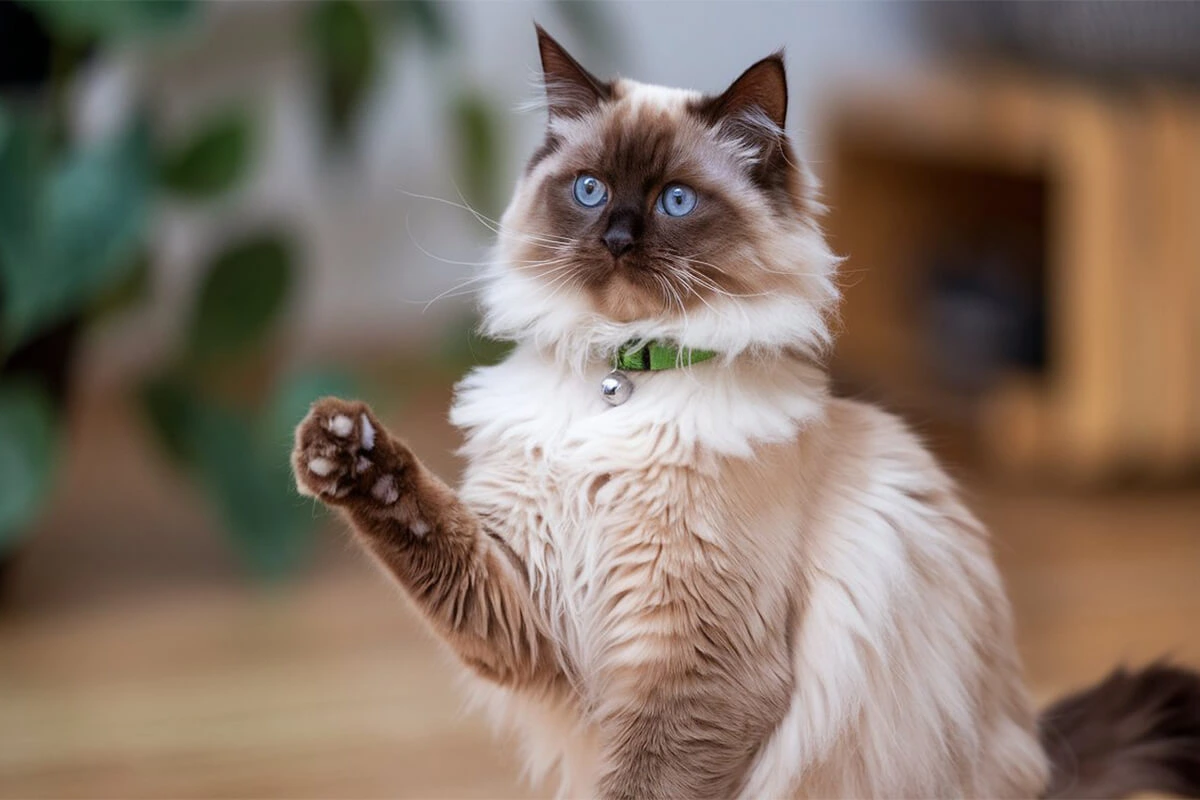
2 thoughts on “Top 10 Tips for Brown Ragdoll Cat Adoption You need to know”
Comments are closed.